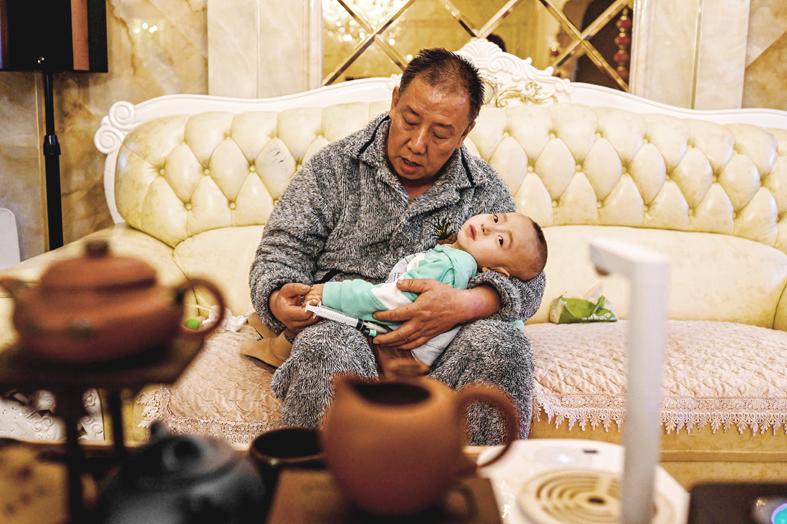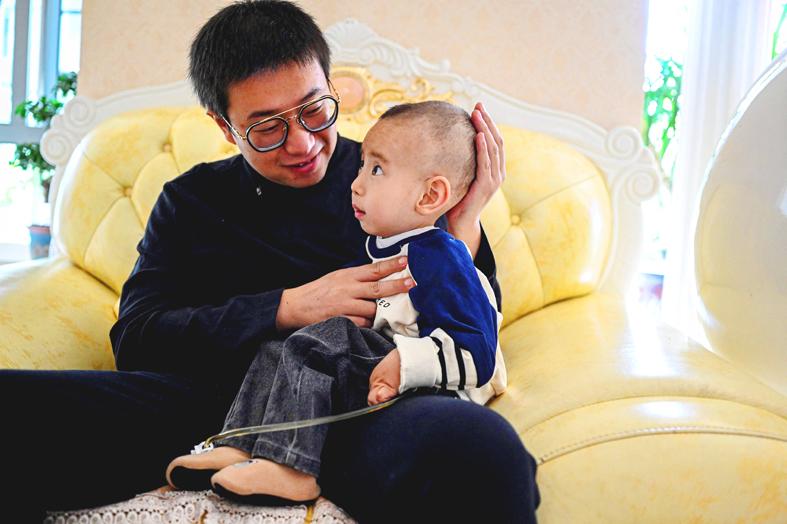Two-year-old Xu Haoyang (徐灝洋) has likely just months to live — but the only medicine that can help his rare genetic condition is not found anywhere in China and closed borders due to the COVID-19 pandemic mean that he cannot travel for treatment.
Instead, his desperate father, Xu Wei (徐偉), has created a home laboratory to create a remedy for the boy himself.
“I didn’t really have time to think about whether to do it or not. It had to be done,” the 30-year-old said from his DIY lab in an apartment building in southwestern Kunming.

Photo: AFP
Haoyang has Menkes syndrome, a genetic disorder that affects how copper — which is crucial for brain and nervous system development — is processed in the body. Those with the syndrome rarely survive beyond the age of three.
However, Xu, who has only a high-school education and ran a small online business before his son became ill, is determined to give him a fighting chance.
“Even though he cannot move or speak, he has a soul and feels emotions,” he said, holding Haoyang in his lap to give him a drink of honey mixed with water.

Photo: AFP
After being told the disease was incurable and the only medication that could help ease symptoms was not available in China, he began researching and teaching himself pharmaceuticals.
Most online documents on Menkes syndrome are in English, but Xu used translation software to understand them, before setting up a home lab in his father’s gym.
On discovering that copper histadine could help, he set up the equipment to create it himself, mixing copper chloride dihydrate with histidine, sodium hydroxide and water.
Now, Xu gives Haoyang a daily dose of homemade medicine, which gives the child some of the copper his body is missing.
The amateur chemist said that a few of the blood tests returned to normal two weeks after beginning the treatment.
The toddler cannot talk, but he gives a smile of recognition when his father runs a gentle hand over his head. His wife, who did not want to give her name, cares for their five-year-old daughter in another part of the city.
Menkes syndrome is more prevalent in boys than girls, and it is estimated that one in 100,000 babies are born with the disease worldwide, organization Rare Diseases said.
There is little information or data available, but Xu said that pharmaceutical companies have shown little interest, as the treatment “does not have commercial value and its user group is small.”
Under normal circumstances, he would have traveled abroad to bring back treatments for Haoyang from specialist centers overseas, but China has largely closed its borders since the start of the COVID-19 pandemic.
Xu felt that he had no choice but to make the medicines himself.
“At first, I thought it was a joke,” Haoyang’s grandfather, Xu Jianhong, said. “[I thought] it was an impossible mission for him.”
However, six weeks after throwing himself into the project, Xu produced his first vial of copper histidine.
To test it, he first experimented with rabbits and then injected the treatment into his own body.
“The rabbits were fine and I was fine, so I tried it on my son,” he said.
Reassured, he then started gradually increasing the dosage — but the medicine is not a cure.
Annick Toutain, rare disease specialist at Tours University Hospital in France, said that the copper treatment “is only efficient against certain genetic anomalies and if it is administered very early on, in the first three weeks of life.”
After that, the treatment would alleviate symptoms, “without leading to recovery,” she said.
Xu has accepted that it can “only slow down the disease.”
His work has led to interest from biotech firm VectorBuilder, which is launching gene therapy research with Xu into Menkes syndrome.
VectorBuilder chief scientist Bruce Lahn described it as “a rare disease among rare diseases,” and said that they were inspired after learning about Xu’s family.
Clinical trials and tests on animals could happen in the next few months.
Xu has even been contacted by other parents whose children have been diagnosed with Menkes, asking him to make treatment for their relatives too — something he has refused.
“I can only be responsible for my child,” he said, while health authorities have said that they would not intervene as long as he only makes the treatment for home use.
Huang Yu (黃昱) of Peking University’s Medical Genetics Department said that as a doctor, he is “ashamed” to hear of Xu’s case.
Huang said he hopes that “as a developing country, we can improve our medical system to better help such families.”
With a full-time role as an amateur chemist, Xu has little income and relies mainly on his parents.
Friends tried to talk him out of his medical efforts, but the young father is planning to study molecular biology at university and do everything he can to protect his son.
“I don’t want him to wait desperately for death. Even if we fail, I want my son to have hope,” he said.

Philippine President Ferdinand Marcos Jr yesterday vowed that those behind bogus flood control projects would be arrested before Christmas, days after deadly back-to-back typhoons left swathes of the country underwater. Scores of construction firm owners, government officials and lawmakers — including Marcos’ cousin congressman — have been accused of pocketing funds for substandard or so-called “ghost” infrastructure projects. The Philippine Department of Finance has estimated the nation’s economy lost up to 118.5 billion pesos (US$2 billion) since 2023 due to corruption in flood control projects. Criminal cases against most of the people implicated are nearly complete, Marcos told reporters. “We don’t file cases for

A feud has broken out between the top leaders of the far-right Alternative for Germany (AfD) party on whether to maintain close ties with Russia. The AfD leader Alice Weidel this week slammed planned visits to Russia by some party lawmakers, while coleader Tino Chrupalla voiced a defense of Russian President Vladimir Putin. The unusual split comes at a time when mainstream politicians have accused the anti-immigration AfD of acting as stooges for the Kremlin and even spying for Russia. The row has also erupted in a year in which the AfD is flying high, often polling above the record 20 percent it

Ecuadorans are today to vote on whether to allow the return of foreign military bases and the drafting of a new constitution that could give the country’s president more power. Voters are to decide on the presence of foreign military bases, which have been banned on Ecuadoran soil since 2008. A “yes” vote would likely bring the return of the US military to the Manta air base on the Pacific coast — once a hub for US anti-drug operations. Other questions concern ending public funding for political parties, reducing the number of lawmakers and creating an elected body that would

‘ATTACK ON CIVILIZATION’: The culture ministry released drawings of six missing statues representing the Roman goddess of Venus, the tallest of which was 40cm Investigators believe that the theft of several ancient statues dating back to the Roman era from Syria’s national museum was likely the work of an individual, not an organized gang, officials said on Wednesday. The National Museum of Damascus was closed after the heist was discovered early on Monday. The museum had reopened in January as the country recovers from a 14-year civil war and the fall of the 54-year al-Assad dynasty last year. On Wednesday, a security vehicle was parked outside the main gate of the museum in central Damascus while security guards stood nearby. People were not allowed in because